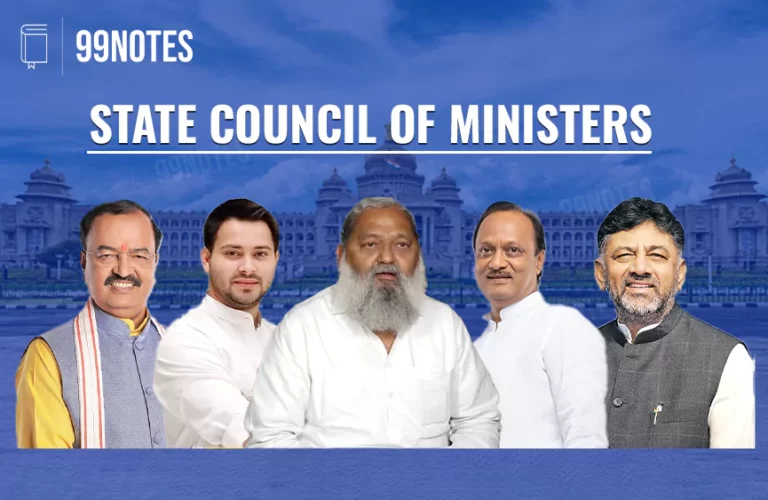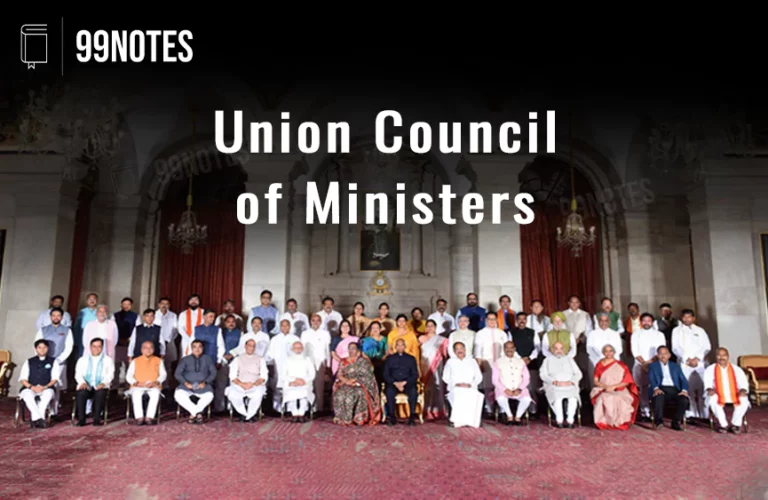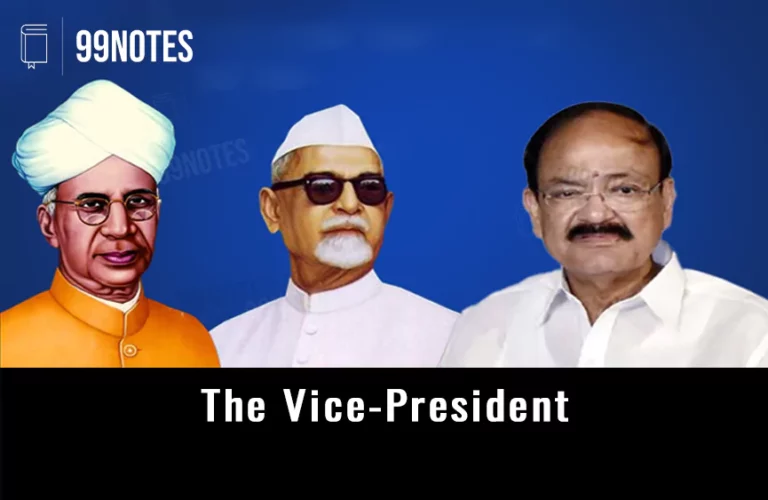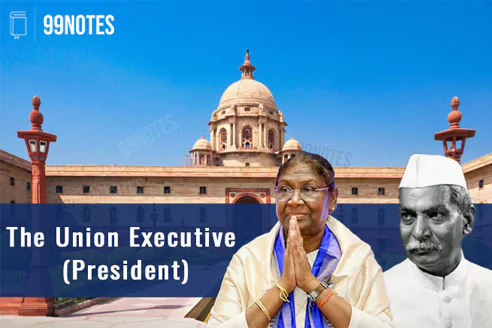The Governor: Appointment, Qualifications, Oath, Power and Functions
Governor of States
Article 153 of the Indian Constitution states that “there shall be a Governor for each state”.
The Constitution of India establishes a Parliamentary form of Government at both central and state levels. Just as the President is the constitutional head of the state, the Governor is the constitutional head of a state (federal units), who is aided by a council of ministers headed by a CM.
Though the Governor is the chief executive head of the state, their position is ceremonial, the same as the President of India. True power lies with the Chief Minister and the Council of Ministers.
Historical Evolution of Governor’s Post
The Governor of the state also serves as a representative of the central Government. This practice originated in the British Raj.
- Regulating Act of 1773: When the Britishers established their rule in India, the empire was divided into three Presidencies – Calcutta, Bombay and Madras, each headed by a Governor.
- Government of India Act, 1858: When the British Crown took control in 1858, the empire was organised into provinces. The office of the Governor, who now acted as an agent of the Viceroy who presented the Crown, was preserved.
- Government of India Act, 1919: Under the Montagu Chelmsford reforms, the Governor was given partial autonomy by demarcating central and provincial subjects. It also introduced a ‘dyarchy’ in which a few provincial subjects were ‘transferred’ to elected representatives.
- Government of India Act, 1935: It introduced ‘provincial autonomy’ and ‘responsible government’ in the provinces under which the Governor was to act on the aid and the advice of the Council of Ministers responsible to the provincial legislature. The Governor acted as a representative of the Federal Government.
The Indian Constitution adopted this Practice.
Appointment of Governor of States
Unlike the President, there is no provision for the election of the Governor; s/he is appointed by the President by warrant under his hand and seal (Article 155). Effectively, the Governor of a state is a nominee of the Central Government.
This is akin to the Canadian model of appointment of Governor, where the Governor-General appoints the Governor of the provinces.
- However, the Supreme Court in 1979 held that the office of the Governor is not an employment under the Government of India; it is an independent Constitutional post and not subordinate to the Union
- Also, the 7th Constitutional Amendment (1956) made it possible to appoint the same Governor for two more states.
Why not an elected Governor?
The draft Constitution had provided for the direct election of the Governor, as is the practice in the United States. However, the Constituent Assembly went for the present system of appointment for the following reasons:
- Responsible Government: The direct election of the Governor is incompatible with the parliamentary system, which the constituent assembly favoured.
- Huge spending and elaborate arrangements for the election of a ceremonial head cannot be justified;
- Risk of Conflict of powers: The election of a Governor could create a parallel authority in the state, and therefore, the Chief Minister would always want his “man” to contest for the post.
- Central hold over states: The system of presidential nomination of the Governor would enable the centre to have a hold over the states.
Qualification and the Conditions for the Post of Governor
The Constitution has prescribed only two qualifications for the post of Governor [Art 157]:
- S/he should be a citizen of India;
- S/he should have completed the age of 35 years.
Further, the Constitution mentions the following conditions [Art 158]:
- S/he should not be a member of either the Parliament or any of the state legislatures. If an MP or MLA is appointed as the Governor, s/he is deemed to have vacated the seats on the date on which s/he enters the office.
- S/he should not hold an office of profit.
Additionally, there have been a few conventions with respect to the appointment of a Governor:
- The Governor should not belong to the state where they are being appointed. This practice is followed so that the Governor is not involved in the state’s local politics.
- The President should consult with the chief minister of the concerned state.
However, both of these conventions above have been violated several times.
Oath and Affirmation of Governor of States
The Governor must subscribe to an oath or affirmation before entering office. The Chief Justice of the concerned state High Court, or, in their absence, the senior-most judge of that High Court, administers the oath to the Governor.
Emoluments and Entitlements enjoyed by the Governor
- The Governor’s emoluments, allowances and privileges are determined by the Parliament. In 2018, the salary of the Governor was increased to ₹3.5 lakhs per month.
- Their salary and allowances cannot be diminished during their term.
- The remunerations of the Governor are ‘charged on’ the consolidated fund of India.
- When the same governor is appointed for two or more states, the remunerations payable to the governor are shared by the states in a manner determined by the president.
- S/he is entitled to rent-free accommodation in their official residence, i.e. Raj Bhawan.
Privileges and Immunities
- Like the President, the Governor also enjoys legal immunity from their official acts.
- S/he is immune from criminal proceedings even for his personal acts and cannot be arrested or imprisoned during the term of office;
- Civil proceedings can be initiated against them for their personal acts after giving two months’ notice.
Term of the Governor of States
- The Constitution, under Article 156, provides that the Governor shall hold the office at the pleasure of the President; it also provides that the Governor would hold the office for a term of 5 years.
- It also mentions that the Governor would continue to hold the office after the expiry of their term until their successor assumes the office.
- The Governor is eligible for re-appointment for any number of times.
- The President can also transfer the Governor from one state to another.
- The Governor can resign at any time by writing a resignation letter to the President.
Removal of the Governor
The Governor holds their office at the pleasure of the President; hence, s/he can be removed by the President at any time. Since the President acts on the aid and advice of the Council of Ministers, effectively, the power to remove the Governor lies with the central Government.
The Constitution does not mention any ground for the removal of the Governor and can be removed at the central Government’s discretion. This ensures that the governor remains the agent of the centre in the state.
Issues Regarding the Appointment and Removal of the Governor |
The appointment and removal of the Governor have been a major cause of contention in Indian politics, especially in centre-state relations.
|
Powers and Functions of a Governor in States
The Constitution of India classifies all powers of the Governor under two heads:
- Executive Powers described under Part VI, Chapter II (Article 153 to 167)
- Legislative Powers (Article 213)
The Governor executes all these powers with the aid and advice of the council of ministers. Article 163 says that “there shall be a Council of Ministers with the Chief Minister at the head to aid and advise the Governor in the exercise of his functions, except in so far as he is by or under this Constitution required to exercise his functions or any of them in his discretion.”
This advice is binding upon the Governor, except where their discretion is required.
Comparison with the President: After the 42nd Constitutional Amendment (1976), the advice of the Council of Ministers was made binding on the President. However, no such change was made explicitly in the case of the Governor. Nevertheless, the various Supreme Court Judgements (such as the Nebam Rebia Case) have made it clear that the Governor cannot act without the advice of the council of ministers.
1. Executive Powers
Governor, with the advice of the State Council of Ministers (Government), can perform the following executive functions:
- The Governor appoints the Chief Minister, and on the recommendation of the Chief Minister, the Governor appoints other ministers.
- Make the rules for more convenient transactions of business of the state government and for the allocation of said business among the ministers.
- Make rules spelling out the manner in which the Orders and other instruments executed in his or her name shall be validated.
- Make various appointments:
- Advocate General of the state who holds his position during the pleasure of the governor, who also determines their remuneration.
- Chairman and members of the State Public Service Commission. However, only the President has the power to remove them.
- State Election Commissioners: The Governor determines their service conditions and tenure. However, the State Election Commissioner can only be removed through a process similar to that of a judge of the High Court.
- Powers related to scheduled areas: S/he is empowered to organise and reorganise the autonomous districts in the scheduled areas under the 6th schedule of the Constitution.
- Emergency Powers: S/he can recommend to the President the imposition of state emergency/President’s rule in the state. S/he also enjoys substantial executive powers as an agent of the President during state emergencies.
2. Ceremonial powers of Executive Nature:
- All the executive actions by the state are carried out in the name of the Governor.
- The Governor serves as the chancellor of universities in the states and also appoints the vice-chancellors of the universities in the states.
3. Financial Powers
- Presentation of Annual Budget: The annual financial statement and supplementary budget are brought in the state legislature in the name of the Governor; no demand-for-grant can be made without their recommendation.
- Money bills: A money bill (Article 110) cannot be introduced in the legislative assembly without the prior recommendation of the Governor.
- Control over Contingency fund of state: S/he can make advances out of the contingency fund of India to meet the deal with unforeseen circumstances.
- Constitutes State Finance Commission: S/he constitutes a state finance commission every 5 years to assess the financial position of the local governments.
4. Judicial Powers
- Role in the appointment of High Court judges: The President, while appointing the judges of the High Court, consults the Governor of the concerned state.
- Appointment of District Judges: The Governor makes the appointments, postings and promotions of a district judge in consultation with the state high court.
- Appointments in other judicial services: S/he also appoints judicial officers other than the district judge in consultation with the state public service commission and state high court.
- Pardoning Power: Like the President, the Governor is also entitled to grant pardon, reprieve, respite, remit, or commute the sentence of a person convicted under state law (You can read the meaning of these terms here). It should be noted that, unlike the President, the Governor cannot pardon a death sentence, though s/he can commute the death sentence.
5. Discretionary Powers of the Governor
There are some powers that the Governor exercises as the representative of the centre; these are called discretionary powers. The Governor’s decision in their discretion is final, and the validity of their actions cannot be questioned in any court. These powers include:
- Recommendation for President’s Rule: In case of a breakdown of constitutional machinery in the state, the Governor may report the situation to the President for the imposition of presidential rule under Article 356.
- There may also be circumstances where the Governor reserves a bill for the President’s consideration.
- Discretion in cases of payment of royalty from mineral exploration to the autonomous districts in Assam, Meghalaya, Tripura and Mizoram.
- Seeking information from the Chief Minister regarding the administrative and legislative matters of the state.
- The governor can require the chief minister (CM) to submit for the consideration of the council of ministers any matter on which a minister has made a decision but which has not been considered by the council.
- Situational Discretionary Powers:
- Inviting parties to form Government when no party has a majority;
- Appointing a Chief Minister when the existing Chief Minister dies suddenly with no obvious successor;
- Dismissal of Council of Ministers when it loses confidence in the legislative assembly;
- Dissolution of the state legislature if the Council of Ministry cannot prove a majority;
Is the discretionary power of the Governor wider than the President?
- From the above comparison of powers between the President and Governor, it is clear that the Governor’s discretionary power is wider than that of the President.
- Further, the 42nd Constitutional Amendment (1976) made the advice of the Council of Ministers binding on the President. However, no such change was made explicitly in the case of the Governor.
6. Legislative Powers
The Governor is an integral part of the state legislature, along with the state legislative assembly (state legislative council, wherever it exists) [Article 168].
Ordinance-making power of the Governor: The Constitution explicitly mentions only one legislative power under the chapter “Legislative power of the Governor.” The Governor has the authority to issue ordinances when the state legislature is not in session. You can read in detail about the ordinance-making power of the Governor here.
However, The State government enjoys various other powers of a Legislative nature on behalf of the Governor.
- Convenes assembly: The Governor summons and prorogues the state assembly and can also dissolve the state legislative assembly.
- Appointments and nominations: On the advice of the Government, the Governor can –
- Appoint any member of the state legislative assembly to preside over the proceedings of the House when the office of Speaker and Deputy Speaker (or chairman in case of legislative council) is vacant;
- Nominate 1/6th members of the state legislative council (in case of bicameral legislature). Such members are eminent persons from different walks of life, such as literature, science, cooperative movement and social service.
- Earlier, the governor could also nominate a person from the Anglo-Indian community, but the 104th Constitutional Amendment Act 2019 discontinued this provision).
- Presents reports to the assembly: The reports of the State Finance Commission, State Public Service Commission and, Comptroller and Auditor General of India (relating to accounts of states) are laid before the state legislature in the name of the Governor.
- Powers regarding scheduled areas: The Governor has the following powers with respect to territories under the 5th schedule:
-
- The Governor is empowered to direct that a particular law made by the Parliament or state legislature would not apply to a scheduled area or a part of it or would apply in a modified form.
- The Governor is empowered to make laws for good governance and peace in the scheduled area after consulting with the Tribal advisory council.
Discretionary Legislative Power of the Governor
Governor also enjoys certain legislative powers of a discretionary nature:
- Communicates with Legislature: S/he can send messages to the state legislature regarding any pending bill in the legislature or otherwise.
- Assents the bills: The Governor’s assent is required for a bill passed by the state assembly to become a law; in this s/he has the following powers:
-
- S/he may give assent to the bill; in that case, the bill becomes law;
- S/he may withhold the assent, in which case the bill fails to become a law (Absolute veto);
- S/he may return the bill, but If the State Legislature passes the bill in its original shape or in a modified form, the Governor has to give assent to the bill (Suspensive veto);
- S/he may reserve the bill for the consideration of the President.
Governor’s Legislative powers of Ceremonial nature:
- Administers oaths and affirmations to members: Every member of the state legislative assembly and legislative council must subscribe to an oath or affirmation before the Governor or any other person nominated by them for that purpose.
- Special address in Legislative assembly: S/he addresses the first session of state legislature (or joint session in case of bicameral legislature) after the general elections to the state assembly and the first session of each year.
Difference between the Powers of the Governor and the President
The Constitution has defined somewhat similar roles for the President and the Governor as the head of the executive at the centre and in the state, respectively. However, there are some differences as well in terms of their powers and functions, which we will discuss here.
1. With Respect to Assenting Bills
- The Governor enjoys powers similar to the President, which means s/he can either give assent, withhold the assent, or return the bill for reconsideration.
- An additional power that the Governor enjoys is s/he can reserve the bill for the President’s consideration. In this case, if the President returns the bill and the legislative assembly repasses it within 6 months, the bill directly goes to the President, which means the assent of the Governor is no longer required.
- It should be noted that the President is not bound to give assent even after the bill is sent again for reconsideration (The Constitution is silent on this provision).
2. With Respect to Money Bill
- In the case of the Money bill, too, the only difference is that the Governor can reserve the bill for the reconsideration of the President.
- After s/he reserves the bill for reconsideration, his/her role regarding that bill ends.
3. With Respect to the Ordinance Making Power
- The ordinance-making power of both the Governor and the President is the same except for one condition.
- The Governor cannot promulgate an ordinance with the instruction from the President in the following cases:
-
- If a bill containing the same provisions as in the ordinance would have needed the prior recommendation of the President for its introduction in the state legislature, for example, legislation which has implications on freedom of trade and commerce.
- If the Governor would have deemed it necessary to reserve a bill with similar provisions for the consideration of the President.
- The Governor cannot issue an ordinance with a provision similar to legislation that has failed to get the President’s assent.
4. With Respect to the Pardoning Power
- The President has the power to grant pardon, reprieve, remit, suspend or commute the punishment or sentence of any person convicted under a central law. You can read it in detail from here.
- The Governor has the power to grant pardon, reprieve, remit, suspend or commute the punishment or sentence of any person convicted under state law.
- The Governor cannot pardon a death sentence even if the conviction is under state law; the President is the only authority to do that. However, the Governor can suspend, remit or commute a death sentence.
- The President has pardoning powers with regard to punishment or sentence by a military court (court-martial). The Governor does not have such powers.
Governor and Centre-State Relations
The post of governor has been an issue of contention in centre-state relations. Since independence, various state governments have resented the role of Governor in four ways:
- The Centre controls the appointment and removal of Governors.
- Governor’s partisan role: The Governor acts as the Centre’s agent and often uses their position to push its political agenda. Further, the Governor often belongs to the ruling party in the centre.
- Reservation of state bills for the consideration of the President: The Governor often reserves a bill against the advice of a state to serve the interest of the central Government.
- Arbitrary imposition of President’s rule (Article 356) instead of using it as a last resort. For instance, When the Janata Government (in 1980) came into power at the Centre, it dismissed the congress government in nine states.
Recommendations and Judicial Pronouncements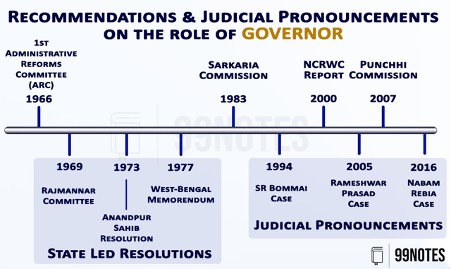
The voices of dissent grew louder, especially after the emergence of non-Congress state governments post-1967. Over the years, several committees and judicial rulings have recommended ways to reduce the tension between the states and centre over the post of Governor. These are as follows –
1. On Centre’s control over the Governor
- Administrative Reforms Committee (1966) recommended that during the appointment of the Governor, it should be ensured that the person has a long experience in public life and administration and a non-partisan attitude.
- Rajamannar Committee (By the DMK government of Tamil Nadu in 1969) recommended that the provision that the state council of ministers holds office at the pleasure of the Governor should be omitted.
- Sarkaria Commission (1983) recommended that a procedure to consult the states in the appointment of Governors should be mentioned in the Constitution itself.
- Punchhi Commission (2007) recommended that the governor should be:
- Person of eminence in some walk of life.
- Domiciled outside the State.
- A politically detached figure.
- Having a fixed tenure of five years, which could not be altered at the whims of the Centre.
- The Punchhi Commission further recommends that the process of impeachment of the President be replicated for the removal of the Governor.
2. On President’s rule:
- Sarkaria Commission (1983) opined that the Governor cannot dismiss a council of ministers so long it enjoys a majority. The Constitution does not give general discretionary power to the Governor; even in this limited choice, their actions should not be arbitrary. Punchhi Commission (2007) recommends the Governor provide adequate time for the CM to prove a majority.
- SR Bommai Case (1994): In the 1990s, several state ministries (Karnataka, Meghalaya, Nagaland, Madhya Pradesh, Rajasthan and Himachal Pradesh) were dismissed for various reasons under Article 356. The Supreme Court thus ruled that the Governor cannot dismiss the state ministry without giving ample time and opportunity to prove its majority on the floor of the House. [Read more here]
- National Commission to Review the Working of the Constitution (NCRWC, 2000) further recommended that the confidence of the Council of Ministers should be tested only on the floor of the House. As long as the ministry has the confidence of the House, the Governor shouldn’t dismiss it.
- Rameshwar Prasad Case (Bihar assembly dissolution case, 2005): In 2005, the President’s rule was declared in Bihar on the Governor’s recommendations, and later, the assembly was also dissolved, and fresh elections were announced. When the matter came to the Supreme Court, it declared that the President’s proclamation of dissolution of the assembly was unconstitutional since the Governor did not give ample time and opportunity to the parties to form the Government. Although, the assembly couldn’t be restored since fresh elections had already been notified.
- Nabam Rebia Case (Arunachal Pradesh assembly case): In 2016, the Governor of Arunachal Pradesh had advanced the meeting of the assembly without the recommendation of the Council of Ministers and put the removal of the speaker on the agenda of the meeting. In this case, the Supreme Court ruled that as per Article 174 (read with Article 163) the Governor can summon, prorogue and dissolve the state legislative only on the recommendation of the Cabinet.
3. On the appointment of the Government:
Punchhi Commission (2007) gives a clear set of instructions that must be followed during the formation of the Government:
- The party or combination of parties that holds the majority in the Legislative Assembly should be invited to form the Government.
- If there is a pre-poll alliance or coalition, it should be regarded as one political party, and if such coalition gets a majority, the leader of such coalition shall be invited by the Governor to form the Government.
- In case no party or pre-poll coalition has been able to obtain a majority, the Governor should select the Chief Minister in the order preference indicated here:
- The group of parties that had pre-poll alliances held the largest number.
- The single largest party is staking a claim to form the Government with the backing of others.
- A post-election coalition with all partners becoming part of the Government.
- A post-electoral alliance with some parties becoming part of the Government and the remaining, including independents backing the Government from outside.
4. On Reservation of bills for the President’s consideration:
- Sarkaria Commission (1983): If the President withholds a bill, the reasons should be communicated to the states.
- NCRWC (2000) and Punchhi Commission (2007) recommend that there should be a time limit within which the President has to act.
Punchhi Commission also recommends that there should be a time limit of six months should be prescribed for the Governor to act on the bills passed by the state legislature.
Position of Governor
In a Parliamentary system, the position of Governor is a ceremonial one. Like the President, s/he is also bound to act on the aid and the advice of the state council of Ministers, and only on a few conditions does the Governor exercise situational discretionary powers.
These situational discretionary powers have been the bone of contention in centre-state relations. The situation has been exacerbated by deterioration in political standards, political defections and fragmentation of parties.
The politicisation of the Governor’s post has led to the Governor being seen as an “agent of the centre”, which is demeaning for a constitutional position.
However, the post of Governor is not just about contentions and controversies. It is a link between the centre and the state and plays a crucial role in emergency situations, such as during a breakdown in the constitutional machinery and a threat to the nation’s unity and integrity.
To maintain the dignity of the post as envisaged by the constitution-makers and to strengthen the spirit of cooperative federalism, reforms, as suggested by various committees, commissions and judicial observations, must be implemented wherever possible.
Other Related Links:
| President of India | Vice President |
| Prime Minister | Union Councils of Ministers |
| Chief Minister | State Council of Ministers |




